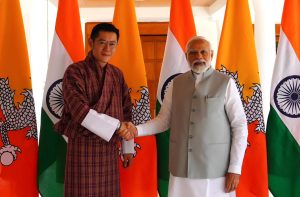From April 3 to 5, Bhutan’s King Jigme Khesar Namgyel Wangchuck visited New Delhi, where he met with President Droupadi Murmu and Prime Minister Narendra Modi. In their subsequent joint statement, the two sides reaffirmed their friendly relations and noted with satisfaction their economic ties.
Despite these amicable displays, Indian media connected the king’s diplomatic initiative with a recent controversy that has left Indian commentators fuming. In a March interview with Belgian daily La Libre, Bhutan’s Prime Minister Lotay Tshering made several comments about Bhutan’s border disputes with China, in which India supports Bhutan. Referring to recent negotiations, Tshering said that “after one or two more meetings, [China and Bhutan] will probably be able to draw a dividing line.” He also denied there had been Chinese intrusions into Bhutan, “such as mentioned by the media.”
The comments have caused a media storm in New Delhi. Indian news site Firstpost speculated that Bhutan might have traded away territory in the coveted Doklam Plateau in exchange for other disputed land in the north. Such a deal would essentially sidestep India in a vitally important territorial dispute. Similarly, the Tribune described Tshering as “cozying up to Beijing” and offering to give China “a clear view of the sensitive Siliguri corridor,” which would gravely threaten Indian security.
The flurry of media attention prompted a response from Bhutan’s prime minister, who explained that his words did not indicate any policy change. However, the king’s recent diplomatic initiative might indicate that this clarification has not been enough. While sources say Jigme Khesar’s visit “has been in the works for some time,” Indian news suggested it provided “an opportunity to India [sic] and Bhutanese officials to exchange notes on the issue.”
The timing also lends the king’s visit special significance. Due to his stay in India, Jigme Khesar only returned in time for the last day of Paro Tshechu, an important festival that commemorates the venerated Guru Rinpoche.
Why did Tshering’s remarks cause such controversy?
Bhutan and China are locked in a border dispute in several areas, a fact that directly concerns India. Until 2007, the Indo-Bhutan Friendship Treaty gave India extensive powers over guiding Bhutan’s foreign policy, which New Delhi still retains in a limited form. Bhutan’s military is trained by the Indian Armed Forces, and having no air force of its own, it relies on India for air defense. Bhutan also benefits from generous Indian development aid, a financial arrangement that dates back to the days of the British Raj.
However, the dependency is not entirely one-sided. Bhutan has occasionally assisted India in quelling regional turmoil, most famously in 2003 when its army dislodged rebels who had been raiding Assam from Bhutanese territory. India also relies on Bhutan as a bulwark against Chinese security threats in the Himalayas. The country sits just north of India’s Siliguri Corridor, also known as the Chicken’s Neck, a 20 kilometer-wide stretch of land that connects India to its eight northeastern states.
It is precisely the Siliguri Corridor that has India worried over Bhutan’s negotiations with China. In a Foreign Policy piece from 2021, Tibetologist Robert Barnett warned that China is building villages and other infrastructure in several territories disputed with Bhutan. It is widely known that China has been building roads in areas claimed by Bhutan since the early 2000s. In 2017, this sparked a standoff with the Indian military, which intervened on Bhutan’s behalf to halt the roadwork on the Doklam Plateau. Barnett’s findings, however, are qualitatively different: They suggest China is trying to use incursions into a sacred Bhutanese valley in the north to force concessions over Doklam.
Sitting at the trijunction between India, China, and Bhutan, the Doklam Plateau and nearby disputed areas are just 100 km from the Siliguri Corridor. As Firstpost explained, Chinese troops stationed at Doklam would be hidden “from the eyes and range of Indian forces” and within easy range of the vulnerable Chicken’s Neck. In the event of a conflict between the two superpowers, “Beijing would be able to roll down Zimplri Ridge and undermine Indian defenses in the Siliguri Corridor.”
Nevertheless, Barnett argued that because of Bhutan’s treaty obligation to respect India’s security needs, the country simply cannot give Doklam to China. The Bhutanese prime minister’s words, he says, have been misinterpreted by Indian media, when in fact, Tshering had bracketed the issue of Doklam for further trilateral negotiation. The settlement to which Tshering alluded concerns areas outside Doklam, which are of negligible strategic importance to India.
According to Barnett, Tshering’s interview is really a story of extreme Chinese pressure on small neighbors and China’s adherence to international agreements. Since Bhutan cannot concede to China in Doklam, it will likely fail to reclaim the areas that China has seized with its new villages. Tshering seems to have recognized this reality by admitting that Chinese infrastructure is “not in Bhutan.” As Barnett pointed out, that statement clearly contradicts Bhutanese claims up until this point, as well as international maps of the Bhutan-China border.
We do not know whether King Jigme Khesar discussed border issues with Modi. The joint statement published at the conclusion of his visit does not mention them, but the visit’s timing and India’s media spotlight certainly made such a discussion likely. However, what remains truly unclear is whether India plans to assist Bhutan in disputes with China farther away from its own borders than Doklam, and whether it is even able to do so.

































